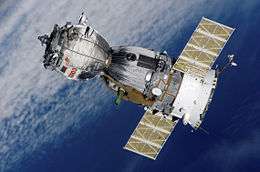Soyuz T-11
| COSPAR ID | 1984-032A | ||||
|---|---|---|---|---|---|
| Mission duration | 181 days, 21 hours, 48 minutes, | ||||
| Orbits completed | ~2,935 | ||||
| Spacecraft properties | |||||
| Spacecraft type | Soyuz-T | ||||
| Manufacturer | NPO Energia | ||||
| Launch mass | 6,850 kilograms (15,100 lb) | ||||
| Crew | |||||
| Crew size | 3 | ||||
| Launching |
Yury Malyshev Gennady Strekalov Rakesh Sharma | ||||
| Landing |
Leonid Kizim Vladimir Solovyov Oleg Atkov | ||||
| Callsign | Jupiter | ||||
| Start of mission | |||||
| Launch date | 3 April 1984, 13:08:00 UTC | ||||
| Rocket | Soyuz-U | ||||
| Launch site | Baikonur 31/6 | ||||
| End of mission | |||||
| Landing date | 2 October 1984, 10:57:00 UTC | ||||
| Landing site | 46 kilometres (29 mi) E of Arkalyk | ||||
| Orbital parameters | |||||
| Reference system | Geocentric | ||||
| Regime | Low Earth | ||||
| Perigee | 195 kilometres (121 mi) | ||||
| Apogee | 224 kilometres (139 mi) | ||||
| Inclination | 51.6 degrees | ||||
| Period | 88.7 minutes | ||||
| Docking with Salyut 7 | |||||

| |||||
Soyuz T-11 was the 6th expedition to Salyut 7, and carried the first Indian cosmonaut to the Salyut 7 station.
Salyut 7 was unmanned after the undocking of Soyuz T-11 in October 1984 until Soyuz T-13 docked with the station in June 1985. Salyut 7 developed problems during the unmanned time, which meant that the crew of Soyuz T-13 had to perform a manual docking and do repairs to the station.
Crew
| Position | Launching crew | Landing crew |
|---|---|---|
| Commander | Yury Malyshev Second spaceflight |
Leonid Kizim Second spaceflight |
| Flight Engineer | Gennady Strekalov Third spaceflight |
Vladimir Solovyov First spaceflight |
| Research Cosmonaut | Rakesh Sharma First spaceflight |
Oleg Atkov First spaceflight |
Backup crew
| Position | Crew | |
|---|---|---|
| Commander | Anatoli Berezovoy | |
| Flight Engineer | Georgi Grechko | |
| Research Cosmonaut | Ravish Malhotra | |
Mission parameters
- Mass: 6850 kg
- Perigee: 195 km
- Apogee: 224 km
- Inclination: 51.6°
- Period: 88.7 minutes
Mission highlights
Rakesh Sharma conducted an Earth observation program concentrating on India. He also did life sciences and materials processing experiments, including silicium fusing tests. He is also reported to have experimented with practicing yoga to deal with the effects of prolonged orbital spaceflight.[1]
References
This article is issued from Wikipedia - version of the 9/12/2016. The text is available under the Creative Commons Attribution/Share Alike but additional terms may apply for the media files.

